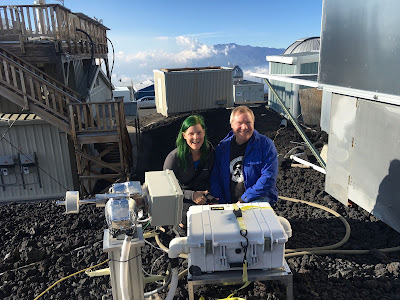PANOPTES at RTSRE and iNATS, 2018
I recently spent a week in Hilo, Hawaii attending two back to back conferences on behalf of Project PANOPTES:
We were lucky enough to have our speaking on Monday afternoon, so we had lots of opportunities to talk in the hallways, at meals, etc. about PANOPTES, and also how it relates to the broader topic of astronomy education. We had several parties express serious interest in building a PANOPTES scope, one of whom was interested in trying out a ZWO camera in place of the Canon SL2 that we currently recommend. I'll be working to build those relationships and support them if they build one of the scopes.
- Robotic Telescopes, Student Research and Education (RTSRE)
- International Astronomy Teaching Summit (iNATS)
Olivier Guyon, Jen Tong and I delivered talks about PANOPTES. Olivier spoke about the historical background of the project, the challenges with using DSLRs for photometry and the the approach used to and science, I followed that with a walk through the process of building a robotic telescope as designed by Olivier and the rest of the PANOPTES team, after which Jen spoke about the application of Cloud Computing to Project PANOPTES. We wrapped up with a brief Q&A for all 5 PANOPTES team members in attendance (Josh Walawender and Kathy Guyon were supporting us from the audience). Most of the questions were familiar to us, such as:
- Why two cameras? Better étendue for the money. Soon we'll have an article on the projectpanoptes.org site explaining that.
- How much does it cost? Under 5,000 USD, including purchasing a few specialized tools that most folks won't have on hand.
- Will it work in a city? Honestly, we're not sure yet. We'd love to have someone try, and if it doesn't work the scope could then be relocated to a more rural location.
- Can it really work with a DSLR and an 85mm lens? Yes, at least on Mauna Loa. We're still evaluating the data from my scope located in Norton, MA. If that turns out to be too light polluted, I'll look to move it further from the suburban light pollution.
See the FAQ for many more such questions. Another category of questions was about how to use this for education:
- Is the existing data available? Yes, just let us know what you're looking for and we'll provide a pointer. We hope one day to have a decent web interface for self-service, but we're not there yet. If you'd like to help with building that, please speak up!
- Can students build the scope? Yes, definitely! The current design was the result of a long effort to make the scope low-cost, weatherproof and easy to build. With the exception of the pier, I built my scope using the type of tools many homeowners have: a hand-held electric drill, a rotary tool (Dremel), a hacksaw, a vice, wire strippers and a soldering iron. These are all tools that a high school FIRST Robotics team would use. And we already have one high school student doing a build as a personal project, rather than as a school activity.
We were lucky enough to have our speaking on Monday afternoon, so we had lots of opportunities to talk in the hallways, at meals, etc. about PANOPTES, and also how it relates to the broader topic of astronomy education. We had several parties express serious interest in building a PANOPTES scope, one of whom was interested in trying out a ZWO camera in place of the Canon SL2 that we currently recommend. I'll be working to build those relationships and support them if they build one of the scopes.
A fun side trip was added at the last minute: a tour of the Mauna Loa observatory, altitude 11,000 feet! This is the home of PAN001, the first instance of the design that I built. Here's a picture of Jen and me along side PAN001, with Mauna Kea in the background:


Comments
Post a Comment